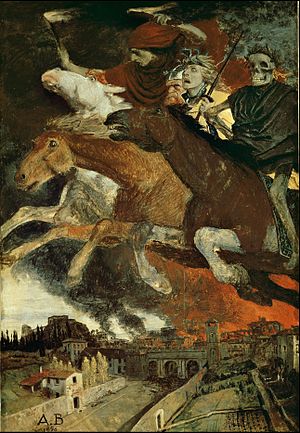The war (Böcklin, Dresden)

|
| The war |
|---|
| Arnold Böcklin , 1896 |
| Oil on linden wood |
| 100 × 69.5 cm |
|
New Masters Gallery in the Albertinum State Art Collections Dresden |
The war is a painting by the Swiss painter Arnold Böcklin from 1896. It is exhibited in the Neue Meister gallery in the Albertinum in Dresden . There is a painting of the same name by Böcklin that is on display at the Kunsthaus Zürich .
description
The picture shows the Apocalyptic Horsemen in a free adaptation of the fall of the world after the Revelation of John . In contrast to Dürer's woodcut from 1498, Böcklin only depicts three ominous people on wildly galloping horses - war, plague and death. The war is almost completely obscured by the Medusa-headed plague, which from the viewer's perspective rides to the right of him . She wears a sulfur-yellow robe and shoulder a sword on her left. Death follows on the right edge of the picture, riding his horse, confident of victory. His skull is crowned with a laurel wreath. Its depiction is reminiscent of a woodcut by Alfred Rethel or medieval depictions of the Triumph of Death . On the hem of his saddle blanket the four letters are ALEP to read what the Greek word aleptos ( invincible , invulnerable can stand). A woman dressed in red with fire torches in her hands belongs to the entourage of the riders. The town below the group, over which the woman spreads fire, can be identified as a Tuscan town based on the architecture and landscape .
The picture is drawn with A. B 1896 lower left .
history
Böcklin created the picture a few years before his death in Italy, where he had lived since 1895. At this point in time he was marked by illness, strokes of fate and lack of money, so it was a personal interpretation of supernatural destructive forces. After Rolf Andree , at the end of 1895 he wanted to name the painting And the Unfortunate Steps Fast ; in June 1896 he called it Brand. Dissatisfied with the picture (he described it as "already unsuccessful in the system"), he began a second version in December 1896, but it remained unfinished.
For a long time the Gemäldegalerie Dresden boycotted the purchase of Böcklin's pictures. It was not until 1890 that she acquired Böcklins Frühlingreigen . After two more of his works were donated to the inventory, shortly after Böcklin's death in 1902, the gallery bought the painting The War from Rudolf von Kaufmann's private collection. The work was exhibited on the second floor of the Sempergalerie , where the modern department of the picture gallery had been housed since 1890. Böcklin's Der Krieg was not represented at the first public presentation of the collection of paintings from the 19th and 20th centuries after the Second World War in the 1950s in the Bergpalais of Pillnitz Castle , as it was "difficult to access today in its theatricality" . In the new hanging in the Albertinum, in which the New Masters had been housed since 1965, The War was represented again, if only "tolerated". Today it is on display in the Klingersaal. It is recorded under gallery number 2535.
literature
- Andreas Dehmer: Painting of the Fin de Siècle. Sandstein Verlag, Dresden 2010, ISBN 978-3-942422-23-9 .
Individual evidence
- ↑ Ulrich Bischoff (Ed.): Galerie Neue Meister, Illustrated Catalog in two volumes, Volume 1 . Dresden / Cologne 2010.
- ^ Rolf Andree: Arnold Böcklin - The paintings ; Basel / Munich 1998, pp. 520-523
- ^ Gertrud Rudolf-Hille. Foreword in: Gemäldegalerie Dresden. Department of the 19th and 20th centuries. Dresden 1957.
- ^ Andreas Dehmer: Painting of the Fin de Siècle. Sandstein Verlag, Dresden 2010, ISBN 978-3-942422-23-9 . Page 15.
Web links
- The war in the online collection of the Staatliche Kunstsammlungen Dresden